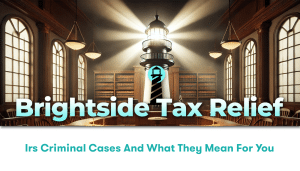Demystifying Tax Levies
As the famous saying goes, the only things certain in life are death and taxes. For many, the latter conjures images of tedious paperwork and a yearly quest to understand the labyrinthine tax code. However, few things induce anxiety about taxes quite like the phrase “tax levies.” It is a term that carries with it a sense of confusion and fear. However, as experts in the field of tax relief, the team at Brightside Tax Relief LLC is here to provide clear, detailed, and educational content on tax levies, their real meaning, and how they operate.
What Exactly is a Tax Levy?
In simple terms, a tax levy is a legal measure used by the IRS (Internal Revenue Service) to collect outstanding taxes. When a taxpayer defaults on payments or fails to comply with a tax agreement, the IRS may place a levy, effectively seizing property to satisfy the debt. However, it’s important to note that a levy doesn’t occur out of the blue. The IRS follows several steps before implementing this drastic measure.
Steps Leading up to a Tax Levy
The IRS does not simply drop a levy bomb without prior notice. Instead, there are several steps leading up to this point:
- A Notice and Demand for Payment is first sent to the taxpayer.
- If the taxpayer fails to pay the demanded amount or set up a payment agreement, the IRS will issue a Final Notice of Intent to Levy.
- If the taxpayer still doesn’t take the necessary steps to resolve their outstanding taxes, the IRS will then proceed with the tax levy.
Forms of Tax Levies
Tax levies can take several forms, depending on the taxpayer’s situation, assets, and the level of cooperation with the IRS. These include:
- Wage Garnishment: The IRS directly takes a portion of the taxpayer’s income from their employer.
- Bank Levy: The IRS freezes the taxpayer’s bank account, withdrawing the amount owed after a grace period.
- Property Seizure: In extreme cases, the IRS can seize property such as homes, cars, or boats.
How to Prevent a Tax Levy
Preventing a tax levy starts with active communication and prompt action when dealing with the IRS. Responding to IRS notices, seeking expert advice, and setting up payment plans are all measures that can stop the levy before it starts.
How to Remove a Tax Levy
Even if a tax levy has been placed on your assets, it’s not the end of the road. Under certain conditions, taxpayers can have tax levies removed. These might include:
- Paying off the tax debt in full.
- Setting up a payment plan with the IRS.
- Demonstrating that the levy is causing economic hardship.
- Proving that the statute of limitations for the tax debt has expired.
For further information, the IRS provides an extensive overview of tax levies and their associated procedures here.
The Role of Brightside Tax Relief LLC
At Brightside Tax Relief LLC, our aim is to alleviate the stress of dealing with tax issues such as levies. With our expertise, we can guide taxpayers through the process, assist in dealing with the IRS and work on strategies to remove or reduce the impact of levies.
A Glimmer of Hope
Understanding the real meaning of tax levies is the first step towards resolving outstanding tax issues. Even if a tax levy has been imposed, there are options available, and Brightside Tax Relief LLC is here to help illuminate the path. Remember, with knowledge, action, and professional advice, there’s always a way to see the bright side of any tax challenge.
Bearing in mind, the information provided in this blog is of a general nature, and for any specific cases, it’s advisable to seek expert advice for personalized solutions. After all, every taxpayer’s situation is unique, and at Brightside Tax Relief LLC, we treat it that way.




